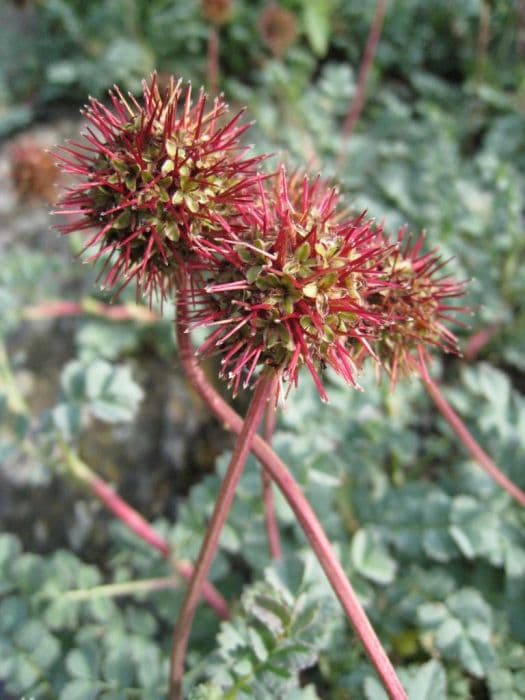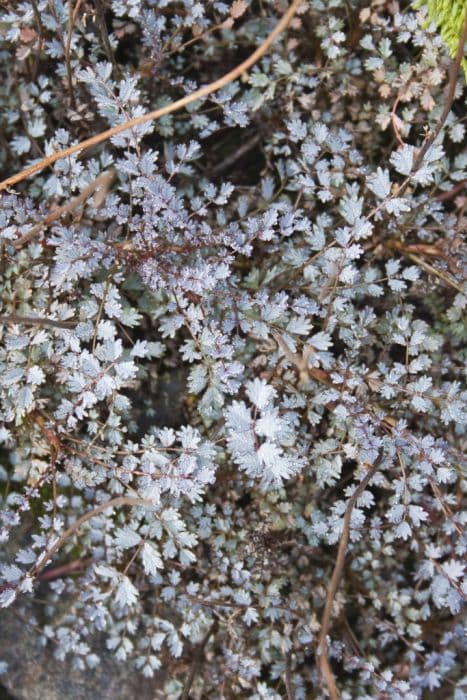Star Magnolia Prunus pendula 'Stellata'

ABOUT
The Prunus pendula 'Stellata', commonly known as the Star Magnolia, is a striking ornamental plant celebrated for its beautiful floral display. This deciduous shrub or small tree is characterized by its gracefully spreading branches, which create a rounded, star-like silhouette. During the early spring, before the foliage fully emerges, the Star Magnolia becomes a focal point in the landscape thanks to its abundant, star-shaped flowers. These blossoms are typically white or pale pink, with multiple narrow-petaled flowers that burst open from silky, fuzzy buds, creating a soft and delicate texture. The leaves of the Star Magnolia are oval-shaped and have a lush, green appearance with a smooth, matte finish. As the seasons progress, the foliage provides a pleasant backdrop for other garden elements, before turning to shades of yellow and bronze in the fall, which adds to its ornamental value. After the blooming period, small, inconspicuous fruit pods may appear, which later mature and release seeds. However, the primary appeal of the Star Magnolia remains its enchanting floral display, which heralds the arrival of spring with an exuberant burst of starry blossoms.
About this plant
 Names
NamesSynonyms
Star Magnolia, Starry Magnolia.
Common names
Prunus stellata, Cerasus stellata, Amygdalus stellata.
 Toxicity
ToxicityTo humans
The common name for Prunus pendula 'Stellata' is Star Magnolia. Generally, Star Magnolia is not considered toxic to humans. However, as with many plants, it is not intended for consumption and ingestion should be avoided. If any part of the plant were ingested in large quantities, it could potentially cause stomach upset or discomfort due to the plant's natural compounds, but significant poisoning is not typically expected with this species.
To pets
Star Magnolia is known to be non-toxic to pets. While ingestion of non-food items like plant parts is usually not encouraged due to the potential for intestinal blockage or non-toxic related upset stomach, the Star Magnolia is not known to be poisonous to cats, dogs, or other pets. If a pet ingests a large amount of this plant, they may experience mild gastrointestinal upset, but serious toxic reactions are not commonly expected.
 Characteristics
CharacteristicsLife cycle
Perennials
Foliage type
Deciduous
Color of leaves
Green
Flower color
Pink
Height
15-25 feet (4.57-7.62 meters)
Spread
15-25 feet (4.57-7.62 meters)
Plant type
Tree
Hardiness zones
5
Native area
Asia
Benefits
 General Benefits
General Benefits- Aesthetic Appeal: Adds visual interest to landscapes with its attractive form, pink or white flowers, and decorative bark.
- Seasonal Interest: Offers year-round interest with blossoming in spring, lush foliage in summer, and a striking silhouette in winter.
- Wildlife Attraction: Attracts pollinators such as bees and butterflies, and provides food and habitat for birds.
- Shade Provision: Canopy provides a cooling effect and shade for understory plants and outdoor living spaces.
- Privacy Screen: When planted in groups, it can create a natural privacy barrier for gardens and yards.
- Cultural Significance: Often planted in gardens and parks due to its symbolic meanings in various cultures, including Japan.
- Adaptability: Tolerant to a variety of soil types, adaptable to different landscapes.
- Erosion Control: Its root system helps stabilize the soil and prevent erosion on slopes and banks.
 Medical Properties
Medical PropertiesThis plant is not used for medical purposes.
 Air-purifying Qualities
Air-purifying QualitiesThis plant is not specifically known for air purifying qualities.
 Other Uses
Other Uses- Photography prop: The beautiful blossoms of the Star Cherry can serve as a stunning backdrop for springtime photography sessions, particularly for portraits and wedding photos.
- Bee forage: With its early blooms, the Star Cherry provides an important source of nectar and pollen for bees and other pollinating insects when there are few other flowers available.
- Bonsai: Due to its graceful form and attractive flowers, the Star Cherry can be trained as a bonsai specimen, offering a miniaturized version of its beauty.
- Cultural symbol: In Japan, cherry blossoms, including those of the Star Cherry, hold considerable cultural significance, often being associated with the transient nature of life.
- Craft materials: The dried branches and blossoms of Star Cherry can be used in crafting, such as making wreaths, floral arrangements, or for use in dried flower art projects.
- Educational use: Educational institutions can use the tree as a tool to teach students about plant life cycles, botany, and horticulture.
- Shade provider for smaller plants: The tree can provide dappled shade for shade-loving herbaceous plants planted underneath or nearby.
- Seasonal celebrations: Some cultures use cherry blossoms, including those from Star Cherry trees, as decorations during festivals or seasonal celebrations, particularly in spring.
- Fruit branches for gastronomy: Although the fruits are small and not widely eaten, branches with fruit can be used for decorative purposes in gastronomy, complementing food presentation.
- Cherry blossom tea: The flowers of the Star Cherry can be used to make a light, fragrant tea, although this is less common and typically associated with some other cherry species.
Interesting Facts
 Feng Shui
Feng ShuiThe Star Magnolia is not used in Feng Shui practice.
 Zodiac Sign Compitability
Zodiac Sign CompitabilityThe Star Magnolia is not used in astrology practice.
 Plant Symbolism
Plant Symbolism- Beauty: Known commonly as the Star Magnolia, this plant is often associated with beauty, due to its stunning star-shaped flowers that blossom even before its leaves appear.
- Elegance: The graceful form of the Star Magnolia and its pure white to pinkish flowers represent elegance and poise.
- Purity: White flowers, such as those of the Star Magnolia, are commonly linked to purity and innocence.
- Perseverance: Blooming in the early spring, often when there’s still a chance of frost, the Star Magnolia symbolizes endurance and the ability to overcome challenges.
- Renewal: As a harbinger of spring, the Star Magnolia signifies new beginnings and the renewal of life.
- Nobility: In traditional Japanese culture, where many Prunus species are celebrated, the flowers are seen as a symbol of refinement and nobility.
 Water
WaterThe Star Magnolia should be watered thoroughly, allowing the soil to dry out slightly between waterings. During the growing season in spring and summer, water the plant once a week with about 1 to 1.5 gallons of water, depending on the size of the plant and the weather conditions. In the fall and winter, reduce the frequency to every two weeks or when the soil is dry to the touch. Ensure good drainage to prevent water logging, which can lead to root rot. It's important not to overwater, as the Star Magnolia does not tolerate standing in water.
 Light
LightThe Star Magnolia thrives best in full sun to partial shade. An ideal spot would be where the plant receives at least four to six hours of direct sunlight daily. Some afternoon shade can be beneficial, especially in hotter climates, to prevent leaf scorch. However, too much shade can lead to sparse flowering. Ensure the Star Magnolia is planted in a location where it can receive ample light for healthy growth and bloom.
 Temperature
TemperatureThe Star Magnolia prefers a temperate climate and is hardy in a range of temperatures. It can withstand winter temperatures as low as 5 to -20 degrees Fahrenheit but may experience bud damage in the lower range if a late frost occurs after buds have formed. The ideal temperature range for the Star Magnolia is between 60 and 75 degrees Fahrenheit during its growing season. Excessive heat can be stressful for the plant, so some shade during the hottest part of the day is beneficial.
 Pruning
PruningThe Star Magnolia benefits from pruning to maintain its shape and remove any dead or diseased wood. The best time to prune is after the plant has finished flowering in late spring to early summer, as pruning too early can result in the loss of blooms. Prune sparingly, as the tree does not require heavy pruning, focusing only on maintaining its natural form and removing any crossing branches that might rub against each other and cause wounds.
 Cleaning
CleaningAs needed
 Soil
SoilThe Star Magnolia prefers fertile, well-draining soil enriched with organic matter. A mixture of loam, peat, and sand is ideal, ensuring good drainage while retaining some moisture. The optimal soil pH should be slightly acidic to neutral, ranging from pH 6.0 to 7.5.
 Repotting
RepottingStar Magnolias, being trees, do not typically require repotting as they are planted directly in the ground. If grown in containers, young trees should be repotted every 2-3 years until they reach their desired size.
 Humidity & Misting
Humidity & MistingStar Magnolias are adaptable to outdoor humidity levels and do not require specific humidity conditions. They thrive best in the natural humidity found within their growing zones.
 Suitable locations
Suitable locationsIndoor
Not suitable for indoor growth.
Outdoor
Plant in well-draining soil, full sun to part shade.
Hardiness zone
4-8 USDA
 Life cycle
Life cyclePrunus pendula 'Stellata', commonly known as the Star Magnolia, begins its life cycle when a seed germinates, typically requiring a period of cold stratification to break dormancy. After germinating, the seedling develops a root system and shoots, growing into a young tree with distinctive, star-shaped blossoms appearing in early spring before the leaves. As the tree matures, it enters a vegetative state where growth is focused on expanding its canopy and root system. The flowering stage recurs annually, with the Star Magnolia producing fragrant white or pink flowers, which are then pollinated by insects, leading to the development of fruit. The fruit, a dry aggregate of follicles, matures in late summer, releasing seeds for dispersal by wind or animals. Over time, the tree may reach senescence, experiencing reduced growth and flowering, until it eventually dies, completing its lifecycle.
 Propogation
PropogationPropogation time
Early Spring
Propogation: The most popular method of propagating the Prunus pendula 'Stellata', commonly known as Star Magnolia, is through semi-hardwood cuttings. This process is typically undertaken in late summer when the wood of new growth has begun to mature and firm up. Cuttings should be about 4 to 6 inches (approximately 10 to 15 cm) long and include at least two to three sets of leaves. After cutting, the lower leaves are removed, and the base of the cutting is dipped in rooting hormone to encourage root development. Then, the prepared cutting is inserted into a well-draining potting mix. The pot should then be placed in a warm, humid environment, often covered with a plastic bag or under a propagation dome to retain moisture, and kept out of direct sunlight but in bright, indirect light to foster root growth. After a few weeks to months, when the cuttings have rooted and show signs of new growth, they can be transferred to individual pots and gradually acclimated to outdoor conditions.









